Accepted Scientific Name: Quaqua mammillaris (L.) Bruyns
Bradleya 1: 63 1983.
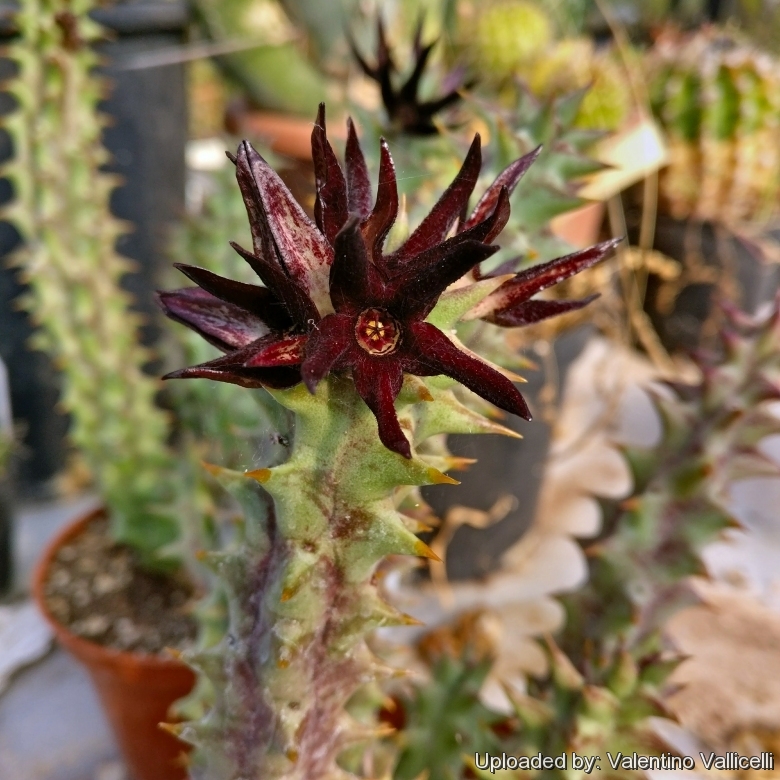
Piaranthus mammillaris (Quaqua mammillaris) Photo by: Valentino Vallicelli
Origin and Habitat: Western South Africa (Northern and Western Cape), and Klinghardt Mountains near Lüderitz in southern Namibia (Caralluma winkleriSN|33141]]SN|33141]]ana).
Habitat and ecology: Quaqua mammillarisSN|33133]]SN|33133]] occurs in most Karoo-Veld types, in rocky hills and on lower slopes of hills at 150-1100 m altitude. There are no signs that Quaqua mammillarisSN|33133]]SN|33133]] is threatened by genetic erosion. Quaqua mammillarisSN|33133]]SN|33133]] is undoubtedly the most widespread species in South Africa, but the plants are often single, wide spaced and difficult to spot. The chance to see them in flower is very rare.
Synonyms:
See all synonyms of Quaqua mammillaris
back
Accepted name in llifle Database:Quaqua mammillaris (L.) BruynsBradleya 1: 63 1983.Synonymy: 11
back
Description: Quaqua mammillarisSN|33133]]SN|33133]] is a much-branched, robust succulent shrub, up to 50 cm high, and 50-70 cm across, branched in a bushy manner which root from the primary stem only. The leaves are transmuted into hard thorns. Bunches of 3-15 velvety purple-brown flowers appears in autumn in the upper 2/3 of the stem, and open simultaneously, but are seldom seen in culture. The corolla is 20-27 mm across, the tube is yellow and purple-spotted. The corona is stipitate (held on a stalk), dark purple-brown, The outer lobes are erect, bifid, fused to the bases of the inner lobes that form pouches. The inner lobes are shortly erect, incumbent on the anthers, and exceed them.The odour of the flowers is extremely disagreeable.
Derivation of specific name: The name refers to the stout tubercles with brown apices (From Lat. “mammilla', nipple ).
Stems: Branching from a single, central stem, erect from base. Branches, erect, glabrous, green, sometimes mottled with purple-brown, 15–50 cm tall and 18–36 cm thick, very variable, short and very compact, sometimes with robust tubercles, or slender-stemmed, irregularly or spirally 4–6-angled. Tubercles 5-20 mm long, conical, spreading, fused near base into the irregularly arranged angles, glabrous, light green, faintly glaucous, armed with stout, yellowish, hard-pointed acute spines 6-12 mm long, with the apical half of the spines brown.
Leaves: Rudimentary, forming the tubercle tooth; stipular denticles absent.
Inflorescence: Flowers in fascicles of 4–15 or more, along the grooves between the angles, usually near the stem tips in the upper 2/3 of the stem.
Flowers: Flowers bisexual, regular, 5-merous. Buds oblong-triangular, basally rounded. Pedicels 2-3 mm long, glabrous, holding the flower horizontally. Sepals 2-4 mm long, ovate, acuminate, glabrous. Corolla campanulate, 20-27 mm in diameter, glabrous and pale green outside, with the tips, margins and a stripe down the middle of the lobes and some dots on the tube very dark purple-brown; inside minutely papillate-setulose on the lobes and upper part of the tube, rich velvety black-purple on the lobes, pale yellowish dotted with blackish purple in the tube, which is 3-6 mm long and as much in diameter. Corolla lobes purple to reddish-black, erectly spreading, 12-20 mm long, about 4-7 mm broad at the base, thence gradually tapering to a very acute apex, longitudinally folded outwards, with revolute margins, inside usually papillose, papillae with an apical horizontally curved thick hair. Outer corona about as long as the staminal column, cupular, 10–15-bi- or trifid, appendages deltoid, glabrous, dark purple-brown. Inner corona-lobes 1-1.5 mm long, subulate or linear, acute to truncate, incumbent on the backs of the anthers and exceeding them, apically meeting and ascending in a curved manner over the style head with more or less connivent-erect tips and a short dorsal projection at the base, adnate to the outer corona and forming 5 of its teeth, dark purple-brown. The corona is variable, especially in the length of the erect tips of the inner lobes.
Fruit: A pair of follicles.
Chromosome number: 2n = 22.
Bibliography: Major references and further lectures
1) N. E. Brown "Flora Capensis" Vol 4, page 518, (1909)
2) Vlok, J. and Schutte-Vlok, A.L. 2010. “Plants of the Klein Karoo” Umdaus Press, Hatfield.
3) Victor, J.E. 2005. Quaqua mammillaris (L.) Bruyns. National Assessment: Red List of South African Plants version 2015.1. Accessed on 2016/08/21
4) Schmelzer, G.H. & Gurib-Fakim, A. “Medicinal plants 2” PROTA, 2013
5) Doreen Court “Succulent Flora of Southern Africa” CRC Press, 01 June 2000
6) Bradleya 1: 64, 59 1983
7) Bruyns, P.V. “Stapeliads of Southern Africa and Madagascar”. Vol. II : 369-415. 2005.
8) James Cullen, Sabina G. Knees, H. Suzanne Cubey “The European Garden Flora Flowering Plants: A Manual for the Identification of Plants Cultivated in Europe, Both Out-of-Doors and Under Glass” Cambridge University Press, 11 August 2011
9) Urs Eggli, Leonard E. Newton “Etymological Dictionary of Succulent Plant Names” Springer Science & Business Media, 29 June 2013
10) J.A. Audissou “Introduction au Genre Quaqua” CACTUS-AVENTURES International N° 88 <https://www.cactuspro.com/articles/_media/quaqua:genre_quaqua_jaa_cai88fr.pdf>
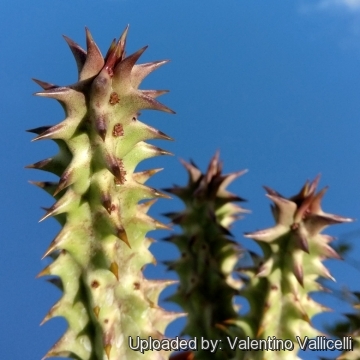 Piaranthus mammillaris (Quaqua mammillaris) Photo by: Valentino Vallicelli
Piaranthus mammillaris (Quaqua mammillaris) Photo by: Valentino Vallicelli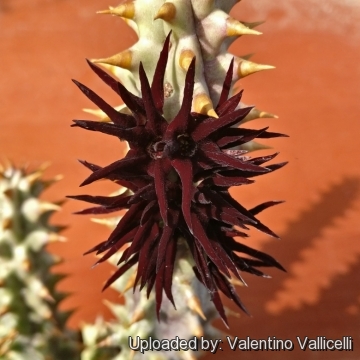 Piaranthus mammillaris (Quaqua mammillaris) Photo by: Valentino Vallicelli
Piaranthus mammillaris (Quaqua mammillaris) Photo by: Valentino Vallicelli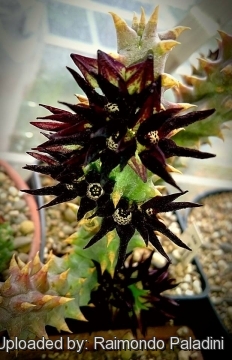 Piaranthus mammillaris (Quaqua mammillaris) Photo by: Raimondo Paladini
Piaranthus mammillaris (Quaqua mammillaris) Photo by: Raimondo Paladini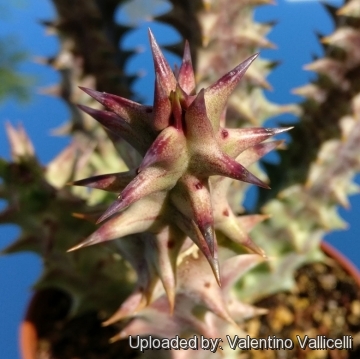 Piaranthus mammillaris (Quaqua mammillaris) Photo by: Valentino Vallicelli
Piaranthus mammillaris (Quaqua mammillaris) Photo by: Valentino Vallicelli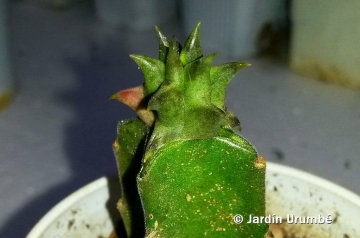 It is occasionally grafted as it is not easy to grow. (Quaqua mammillaris) Photo by: Alexander Arzberger
It is occasionally grafted as it is not easy to grow. (Quaqua mammillaris) Photo by: Alexander Arzberger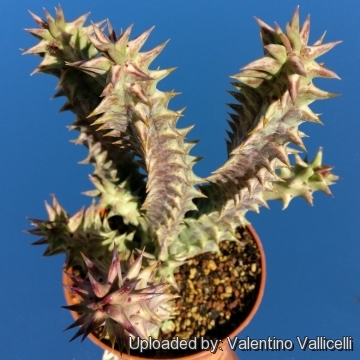 Piaranthus mammillaris (Quaqua mammillaris) Photo by: Valentino Vallicelli
Piaranthus mammillaris (Quaqua mammillaris) Photo by: Valentino Vallicelli Piaranthus mammillaris (Quaqua mammillaris) Photo by: Valentino Vallicelli
Piaranthus mammillaris (Quaqua mammillaris) Photo by: Valentino Vallicelli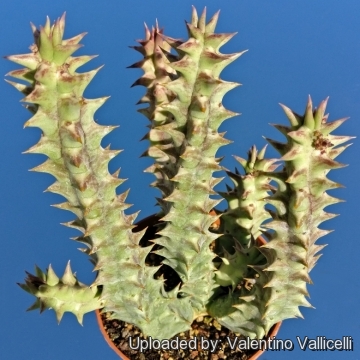 Piaranthus mammillaris (Quaqua mammillaris) Photo by: Valentino Vallicelli
Piaranthus mammillaris (Quaqua mammillaris) Photo by: Valentino VallicelliCultivation and Propagation: Quaqua mammillarisSN|33133]]SN|33133]] is difficult to cultivate.
Soil: The substrate must be essentially mineral.
Watering: Water sparimgly from spring to autumn only when soil is dry.
Hardiness: Quite cold resistant (But needs low ambient humidity).
Uses: Fresh stems are eaten to treat peptic ulcers, to treat hangovers and to reverse drunkenness. A small piece of stem is sufficient to suppress hunger and thirst for a day. Larger quantities can be eaten as a fresh vegetable, but it should not be eaten by pregnant women. The stems of Quaqua mammillarisSN|33133]]SN|33133]] are similarly used as Hoodia spp., as a suppressant of appetite and thirst, but as a medicinal plant, it will probably remain of limited use.
Propagation: The seeds, if fresh, usually germinate easily, but it is a challenge to reach young seedlings to adult size. Stems cuttings often take several months to put forth a root.



















